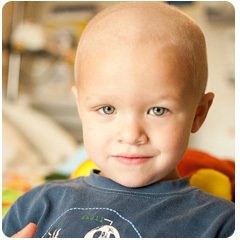 The initial signs can show up in a number of different forms—a mysterious lump on the neck, unexplained weight loss, fevers, fatigue, pain—but the diagnosis always hits like a sledgehammer. Your child has cancer.
The initial signs can show up in a number of different forms—a mysterious lump on the neck, unexplained weight loss, fevers, fatigue, pain—but the diagnosis always hits like a sledgehammer. Your child has cancer.
Amidst your feelings of fear and desperation comes a strong parental instinct to protect and a steely resolve to do everything possible to make your child whole again. Fortunately, you have options. Cancer treatments for children have come a long way in the last 20 years with new breakthroughs happening all of the time. First you must grapple with the key question of what facility is best qualified to treat your child.
To answer that question, you need to know that pediatric cancers behave very differently from adult cancers. Children are not simply smaller adults — their developing bodies and brains respond differently to treatment from the ways an adult responds. What’s more, pediatric cancers can occur anywhere in the body, including the blood and lymph systems, brain and central nervous system, bones, muscle, liver and kidneys. To further complicate matters, pediatric cancer is not one isolated disease — there are over a dozen cancer types and countless subtypes that each require customized treatment based on numerous variables.
Because pediatric cancers are so markedly different from adult cancers, they are most effectively treated in children’s hospitals that specialize in cancer care. In fact, studies have shown that children, adolescents, and young adults treated for cancer in children’s hospitals have a 30% higher survival rate than those treated by oncologists in adult-oriented facilities using the same pediatric cancer protocols.
In addition to looking for a medical facility that specializes in pediatric cancer care, your choice of provider should meet the following criteria:
The provider should offer customized children-specific treatment plans or “roadmaps” that cover all aspects of bringing your child back to wholeness.
The focus should be not only to find a cure for your child’s cancer; the roadmap should also concentrate on preventing the lifelong damage that can result from surgeries, radiation, chemotherapies, and bone marrow transplants that may be needed to eliminate the cancer.
Even during treatment, cancer patients face all kinds of side effects, some uncomfortable and others life-threatening. That’s why your treatment plan should include comprehensive supportive care services that meet your child’s physical, emotional, and social needs.
The provider should have access to cutting-edge research and technology, and offer clinical trials.
There are new advances in cancer treatment that are discovered all the time. That’s why it’s essential to have access to the latest treatment options that are being tested in clinical trials. Look for a children’s hospital or medical center that’s part of the Children’s Oncology Group (COG), the world’s largest organization devoted exclusively to childhood and adolescent cancer research, uniting more than 8,000 experts in childhood cancer at more than 200 children’s hospitals across the world.
Clinical trials allow your child to receive innovative, cutting-edge treatments that may not be available to the general public for several years. A children’s hospital with access to the results of clinical trials is able to constantly refine treatments in order to improve outcomes and reduce negative side effects.
In addition to clinical trials, make sure that the hospital you choose does their own research on-site. A bench-to-bedside approach that integrates both scientific and clinical expertise takes the best ideas from the laboratory to the patient in the form of promising new treatments. In addition, pediatric oncologists use the results of specialized biologic and genetic studies of your child’s cancer cells to determine the best treatment plan for your child. Many of these tests are only available at a childhood cancer center.
The provider should have a multidisciplinary team of specialists who focus not only on the physical aspects of the disease, but also address the emotional needs of both the patient and his/her family.
There is so much ancillary care when it comes to treating cancer. Often the side effects of the treatment require as much ongoing care as the cancer itself. Look for a hospital with a treatment plan that includes social workers, psychologists, child-life specialists, music therapists, financial advisors, insurance counselors, and child-centered care.
Most importantly, take a deep breath and know that even though you and your child have many challenges ahead, pediatric cancer is not a death sentence — far from it. At Primary Children’s Hospital, pediatric cancers are successfully treated and cured in over 85% of the cases — for certain types of cancer, the survival rate jumps to nearly 100%. Because of our expertise and reputation for compassionate care, families with a child diagnosed with cancer come here from all over Utah, the West, and the United States to find a cure and to get back on with their normal lives as quickly as possible.
Reblogged this on Never Give up the Fight .